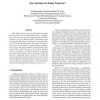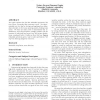19 search results - page 1 / 4 » How Fail-Stop are Faulty Programs |
FTCS
1998
13 years 8 months ago
1998
Most fault-tolerant systems are designed to stop faulty programs before they write permanent data or communicate with other processes. This property (halt-on-failure) forms the co...
SIGSOFT
2002
ACM
14 years 8 months ago
2002
ACM
This paper explores the idea that redundant operations, like type errors, commonly flag correctness errors. We experimentally test this idea by writing and applying four redundanc...
ESOP
2010
Springer
14 years 4 months ago
2010
Springer
Transient faults are single-shot hardware errors caused by high energy particles from space, manufacturing defects, overheating, and other sources. Such faults can be devastating f...
CAV
2006
Springer
13 years 11 months ago
2006
Springer
We show how to find and fix faults in Boolean programs by extending the program to a game. In the game, the protagonist can select an alternative implementation for an incorrect st...
COMPSAC
2011
IEEE
12 years 7 months ago
2011
IEEE
Abstract—Statistical fault localization techniques find suspicious faulty program entities in programs by comparing passed and failed executions. Existing studies show that such ...


